 TileHillKid.UK
TileHillKid.UK
"My
Memories of Tile Hill Village in the 1950's" by James David Elliott
commenced: 22nd March 2007
My Whoberley School Memories:
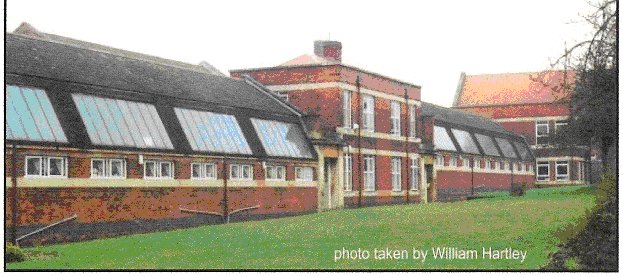
Early
memories are a little faded from the passing of time. I recall the headmistress
Miss Malins of the infant’s school was the headmaster of the senior’s daughter
( keeping it in the family) ! I was sent as a punishment for playing truant
to her to be made to dig a couple of rows in the garden beside the classroom
and plant strawberries. They surprisingly yielded a reasonable crop that was
shared between the teachers while my share was procured during the gathering
session!
When playing truant Graham Robbins and myself would go over Capel’s fields and
play by the brook and on two occasions were caught by my Uncle Clarence who
worked on nearby Capel’s farm.
On moving to the junior school all went quite smoothly with interests in art,
football and real gardening, always keeping our minds and bodies occupied so
no time for serious truancy.
Mr lee was the gardening teacher and at this time is the only name that springs
to mind.
Senior school much the same but with a more serious approach to discipline which
I think taught us that there are rules to be adhered to in life. Teachers were
allowed (within reason) to issue on the spot punishments, which we grew to respect.
I performed in various productions of Opera’s namely “Iolanthe, Merry England
and Toad of Toad Hall”, which we all enjoyed immensely, especially the snogging
in the wings when no authority was watching!
Teachers names remembered are:
Mr Harris, Mr Aldridge, Miss Jones (purple hair) , Mr Lee - maybe others can
add to these?
Where Tile Hill South is now there used to be a gun site housing anti aircraft guns and billets. After the war we rolled hard-boiled eggs at Easter down a crater caused by a dropped German bomb in the vicinity of the flats on Gravel Hill.
I am 11 years old now (my best friend being Graham Robbins) and attending Whoberly
Secondary Modern School and am part of a family that is not particularly well
off so material things are few and far between. Most of our entertainment was
simple and self-motivated like 5 stones played with pebbles, tip it made from
carved wood and walking miles over the fields when not being chased by George
Duggins the local blacksmith or the owner of Nailcotte Hall for pinching his
conkers (used for another of our pleasures). We, like the children of today
also played on the railway banks but were always chased off by the local line
- man (known to our parents) who had a work hut between Tile Hill Station and
the half-mile tunnel. We never tried to disrupt or endanger trains and passengers
– it just never occurred to us – we waved, watched chatted and took train numbers
for hours.
The village on the whole was a comfortable and friendly place to live with the
boundaries mainly in the valley. You could leave doors unlocked then at night
and have no fear of break-ins. Scrumping and the occasional returning of pop
bottles we picked up at the side of Mr Harry Chick’s for a penny a time was
about the worst crimes committed in the village.
We had a resident village Bobby (PC Birchill) to keep us kids in line living
in the house next door to Viners Garage. The little Police station room being
built onto the side of the house but I’m not sure if it had a cell within though
for real criminals.
We had a resident doctors surgery on the corner of Hathaway road with Dr Kerr
and Dr Stuart in attendance who I remember vividly stitching my leg with 5 stitches
and no anaesthetic, 3 inside and 2 out, do I remember that!
I lived in Conway Avenue, which at that time was unadopted and so in a terrible
state, brick ends and rubble from top to bottom. One would not have been able
to ride a bike down it. The Bourne sisters walked their cattle up and down every
morning and night to a field at the bottom for grazing. The milk from these
cows supplied the milk for the community that they delivered on a home made
trolley in churns or you went up to the farm to fetch it and they also worked
the farm.
In the avenue we had a Post Office run by the Dyer family and Mr Carpenter a
printer working from his garage printing letter heads, calling cards etc. for
the surrounding larger companies.
We had a personal teacher that taught privileged children where the post office was.
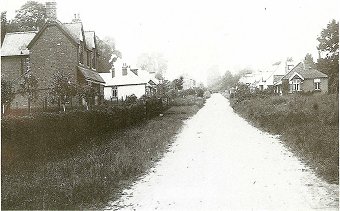 Nailcotte Ave looking up from the “Patch” entrance.
Nailcotte Ave looking up from the “Patch” entrance.
In Nailcotte Ave there was a grocery shop ran by Mr & Mrs Liversey and on the original photograph you can see the advert on the side of the house (top left) for “Lyons Tea”. The little path at the bottom of the photo on the right is the entrance to that we kids call “the patch” but apparently was called “Cross road” and connected Conway Avenue to Nailcote Avenue. Mrs Heath the resident nurse at 69 Conway ran a club in a wooden hut in the patch and also there was an air raid shelter both providing fun for us kids. Graham and I also went on regular occasions to Mr and Mrs Grattans (the last bungalow at the bottom right) where they let us draw straws from a drum with day by day recommendations for a good Christian day rolled up inside.
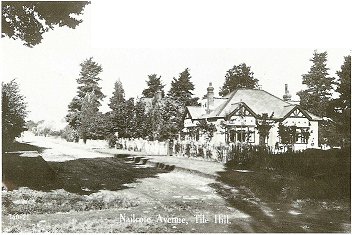 Nailcotte Ave looking up from the Mr McCrainers bungalow. On the corner of Duggins
Lane.
Nailcotte Ave looking up from the Mr McCrainers bungalow. On the corner of Duggins
Lane.
 Station Avenue looking up towards The Bell inn on the left
and carrying on into banner lane.
Station Avenue looking up towards The Bell inn on the left
and carrying on into banner lane.
 Located on the corner was Viners garage where petrol and car
repairs were carried out along with a limited amount of car spare parts.
Located on the corner was Viners garage where petrol and car
repairs were carried out along with a limited amount of car spare parts.
Being spoilt for choice there was another grocery shop called Nellie Smith’s
in Station Ave.
They supplied hardware as well as groceries with the hardware stored and sold
from a wooden garage type addition at the front of the store (this was turned
into a café at a later date) and a small shed housing the potatoes and
tinned fruits etc.
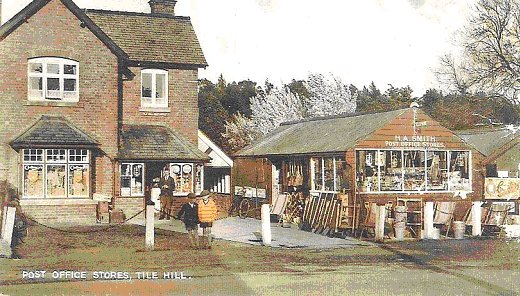
The terraced house connected to Bates the butchers at the top and opposite the garage was owned by the Wise family (Father, Mother and son). Then Bates the Butchers shop that is still being worked as a more versatile butchers shop and the third privately owned but was a solicitor’s office the name of which I think was Abbots but not sure.
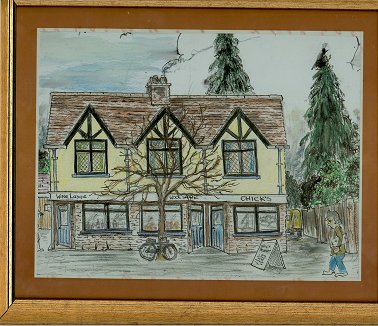 My Painting from memory of the Wine Lodge – Wool shop – Mr
Chick’s Paper Shop in the 1950’s
My Painting from memory of the Wine Lodge – Wool shop – Mr
Chick’s Paper Shop in the 1950’s
Further
down Station Avenue was one building containing 3 shops Mr & Mrs Chick’s
the paper and sweet shop, the wool / dress shop owned by Mrs Tye and the wine
lodge. I had the pleasure of delivering papers for her going to Station Ave,
Conway Ave, Nailcotte Ave, Duggins lane (round the 2 mile block) and Tanners
lane all before school and for a pittance compared to today’s rates.
The local meeting place for the adults was the Bell Inn where many fishing stories
were told and women caught up with gossip. There was a bowling green to the
rear of the pub that my granddad and uncle kept in pristine condition for the
more serious minded sportsmen. Beer drinking was taken just as serious as it
is today with the big drinkers waddling there way home for Sunday dinner and
the remainder stretching out the conversation after pub closure.
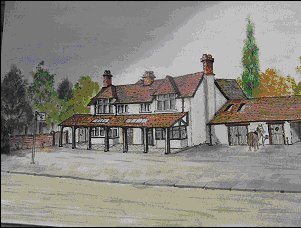 My Painting from memory of the Bell Inn in the 1950’s
My Painting from memory of the Bell Inn in the 1950’s
Ran
by = Mr and Mrs Bull then Mr & Mrs Taylor and Daughter Justine
among others I have yet to recall.
The
village boasted it’s own village hall and vicarage where the vicar put on garden
fete’s in his garden on celebratory occasions to make funds for good causes.
These were brilliant occasions where the village people and surrounding farmers
etc would all meet and pull together to make it a grand day out for all. It
also acted a way of bringing the congregation together – something lacking in
today’s society.
He and the congregation did bowling for the pig, skittles, and various fairground
types of stalls.
I personally enjoyed these functions immensely as everyone always seemed to
enjoy and have fun together.
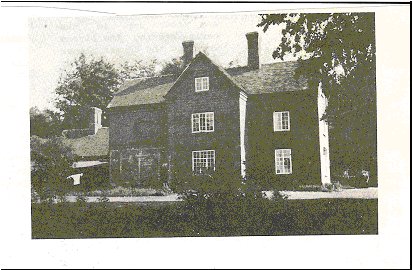
Tile
Hill Vicarage
This is where the garden fetes were held for all around. I remember the wooden
bowl and skittles, although there were many other functions going on. Right
behind the building is Tile Hill woods where we spent most of our after school
time as we could hear our Mothers calling us for tea. I don’t recall a great
deal about the vicar in fact the only mindful event was when I rang the Sunday
school bell because he was late for classes. When he did arrive and ask “Who
rang the bell” my “friends” all stood up pointing to me. It was them that had
dared me to ring it to hurry him up.
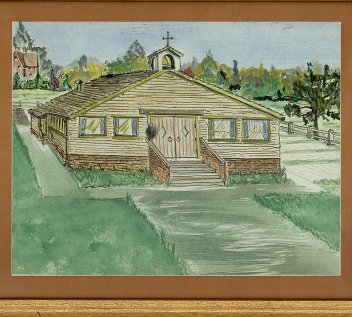 My Painting from memory of the Church Hall in the 1950’s
My Painting from memory of the Church Hall in the 1950’s
The village hall played its part as well having a Sunday school for us kids, women’s meetings, wedding receptions and various other functions. We were called to church with the tolling of the Bell every Sunday morning and afternoon. The one function that comes to mind was the time we approached the Vicar to use the hall for a disco ran by us. We had an electrical record player (nothing fancy) and we purchased non alcoholic drinks from Mrs Chick’s at a reduced price with her taking back what we couldn’t sell along with the empties at a penny each. The Vicar also demanded a portion of the takings leaving Derek, Bill and myself with a little profit. It was quite popular with the local youth, good fun and was trouble free because they knew if trouble erupted the Vicar would withdraw his permission. Along both sides of the hall were well-tended garden allotments, one plot being rented by my Uncle Clarence and my stepfather. I also played a minor part clearing weeds and fetching and carrying tea and sandwiches. The field to the side and rear was I assumed rented to George Duggins for his horses, as there were always horses in the field. Opposite we had what we called Fishers banks, as it was on the now Torrington Ave called because the Standard Triumph body works were on the other side of the road. Two bodies at a time were transported from B’ham to here for dipping and spraying on a 24-hour shift system before going on to Standards Fletchamstead works. They actually caused quite a nuisance because when they were passing the residential part of Nailcotte and Conway Ave. all night and day – the rattle from the empty body shells would wake the devil.
Accommodation for troops during the War was provided in Duggins lane with prefabs, very large dance hall / cinema and on site shops and after the troubles for poor families.
Owned by the Duggins family it had a large house to the rear of the “Smithy”
with a brook running through the land. The last owner before being demolished
for redevelopment was Mr George Duggins lived to the ripe old age of -- . He
was the fittest man for his age that I have ever known ( in his younger years
chasing us off his fields and regularly catching us) walking
at a fast pace everywhere he went on foot, one of those people for whom time
seems to stand still.
Another interest was spending time watching George forging and fitting shoes
to horses. The ringing of the anvil and the sizzling smell of the horse’s hooves
when he burnt the shoes on..
[Photo needed]
CONWAY AVENUE::
Abbots
owned the house next to the butchers in Station Ave but also opened onto Conway
via a latch gate. We used to go and watch all the local bigwigs (gentry) playing
illegal games of cards in an old gypsy type caravan sited under a pear tree.
(Yes we did scrump the pears whenever we could.) out of sight of the village
bobby –PC, Burchill. Other friends around my age in the Avenue were Ronald Bowers
and Sheila Twycross, Laurie Eaves, Barbara Weaver, Norman Spencer, Bill and
Derick Shakespeare, David and Cathleen Carpenter and John Duguid all of us met
over the Patch and played in Bournes field behind the village hotel named “Hewendon
or on rope swings in the trees. “Kim” our old English sheepdog unearthed a wasp’s
nest in the bank and frightened us all into running away.
Mrs Heath had a wooden hut in the patch part that they held cubs meetings or
such in. On the corner was an air raid shelter made of solid reinforced concrete
and smelt inside like an old toilet. Could not have stayed in there for long
even if bombs were dropping. Chatted a girl in the house on the corner called
Jill Reaves – I think she fancied me but was to tall for me so I called it a
day although she was stunning..
A hardware van did regular deliveries to your door from Chatterways of Balsall
Common supplying among other things Paraffin for the home portable heaters and
other household haberdashery items.
More names
Tanners Lane.
There was a small shop in the front room of the house selling potatoes, sweets,
fags and a limited amount of grocery items at the top of Conway Avenue called
Mrs Hill’s. My mother used to send me to her shop as she would open a packet
of Woodbines and sell me 2 wrapped in a sweet bag. The rest and were left in
the original packet selling them individually to other customers in the same
financial state. We couldn’t afford to buy the 10 or 20’s packets.
Opposite the top of Conway avenue was Tanyard Farm owned and run by the Bourne
family. There were two sisters Sis and ? who ran the farm, and three brothers.
Tom, Dan and Alfred.
Dan Bourne lived in a caravan on land in Conway opposite Bowers’s – number?
At the age of 13 Graham and myself worked on Mr and Mrs Herst’s farm as weekend assistants and in the harvest periods at night after school. This was one of the most memorable times in my life . Working with the animals especially the 2 shire working horses and with George. I remember giving one of them cough mixture with the vet present by holding it’s tongue as far out as you could comfortably get it then pour the whole bottle down his throat. Phil Taylor was the main farmhand and lived in a cottage up the entrance lane. His wife cooked the most remarkable meals I have ever had which we ate in the scullery at first and then were privileged to eat with them in the main dining room..
2009 – 05 told I am going to die of terminal cancer to the kidney / lung /lymph nodes stomach and urinary tract ------ what a mess eh
In
memory of James David Elliott
30th January 1939 – 23rd September 2009
please scroll to click on links below
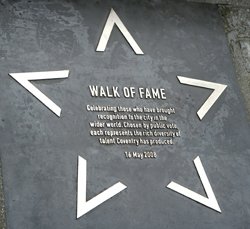
Tile Hill Kid
Walk of Fame - Stars
Tile
Hill Kid - Links
please scroll to click on links below
Arnold Cottages
Bell Inn, Tile Hill Village
Canley Gates [Railway]
Canley Hill
Connoway Farm
Duggins Lane WW2 Hostel
The Old Smithy, Duggins Lane
Fletchampstead Farm
Fletchampstead Hall
Hearsall Farm
Hereward [Further Education] College
Jardine Crescent
Leigh [CofE] Primary School
Limbrick Farm
Limbrick Wood
Limbrick Wood Primary
School
Massey-Ferguson Company
Newlands Pub and Shops
Old Reformatory
Our Lady of the Assumption [Catholic] Primary
School
Park Wood
Pig Wood
Plants Hill Wood
Pound, Tile Hill Lane
Rough Close
Standard Motor Company
Standard-Triumph Social Club
Tanyard Farm
Templars
School Reunion
Templars School
History
The Old Smithy, Duggins Lane
Tile Hill [Further Education] College
Tile Hill Cottages
Tile Hill Farm
Tile Hill Lane
Tile Hill Station [Railway]
Tile Hill Village
Tile Hill Wood
Tile Hill Woodlands Local Nature Reserve
Tile Hill Wood [Girls] Secondary School
Wakefield Cottages
Wakefield Crossing [Railway]
Westwood Vicarage
Whoberley
Whoberley
School Reunion
Whoberley
School History
Whoberley Hall
Whoberley Villa
Woodlands [Boys] Secondary School
WW2
Tile Hill Anti-Aircraft Battery
"My
Memories of Tile Hill Village in the 1950's"
by James David Elliott
Tile
Hill Street Pics
Westcotes 1945 Street Party
![]() join Tile Hill Kids on Facebook
join Tile Hill Kids on Facebook

Tile Hill Kid
Walk of Fame - Stars
bookmark for updates:
http://www.gone-butnotforgotten.uk/tilehillkid/
copyright
1998
Tile Hill Kid
All rights reserved.
Please do not copy any of the website TileHillKid.UK without prior permissions. Any commercial use or any use in future publications is prohibited. If you encounter any problems on this website, please email William@TileHillKid.UK immediately.